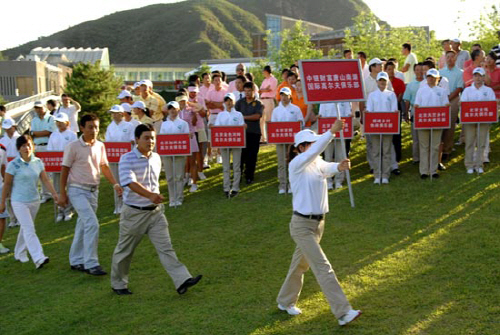중국, 골프장 건설 붐...5년내에 1000개 넘을 듯 Building Golf Courses in China: An Illegal and Booming Industry VIDEO
경제 소득 높아져
2004년 골프장 178개에서 521개로 급증
정부 세수에도 도움되나,
난 개발 우려 정부 규제 늘어나
Photograph by Wang Zhao/AFP via Getty Images
화산 용암지대에 위치해 멋진 풍경을 자랑하는 세계최대 골프장 미션힐 골프클럽의 1코스
kcontents
중국은 원래 골프와는 상당한 거리가 있었다. 골프도 축구처럼 중국이 종주국이라고 주장하는 중국인들이 없는 것은 아니었으나 금세기 초까지만 해도 골프 인구는 터무니 없이 적었다. 골프장은 더 말할 필요조차 없었다. 베이징만 해도 지난 세기 말까지 골프장 수가 손가락으로 꼽을 정도였다. 그러나 지금 상황은 그렇지 않다. 마치 골프 마니어들의 천국이 되지 않을까 싶을 만큼 골프장 건설 붐이 일고 있다. 중앙 정부에서는 가능한 한 건설을 억제하려고 하나 도무지 브레이크가 걸리지 않고 있는 것이 현실이다. 유력 경제지 징지찬카오바오(經濟參考報)의 17일 보도는 현재의 상황을 무엇보다 잘 말해주지 않나 싶다. 이에 따르면 지난 2004년만 해도 중국에는 골프장이 178개 밖에 되지 않았다. 그러나 거의 10년이 지난 지금은 무려 521개에 이른다. 무려 3배 가까이 늘어났다. 문제는 앞으로도 계속 늘어날 것이라는 사실에 있다. 5-6년 내에 1000개는 가볍게 넘을 것으로 추산되고 있다. 이뿐만이 아니다. 허가를 받지 않고 영업을 하는 연습장이나 골프 학교의 그린까지 합치면 그 수는 기하급수적으로 늘어난다. 이처럼 너무 심하다고 할 정도로 골프장이 늘어나는 것은 당연히 수요가 뒷받침되기 때문이 아닌가 보인다. 베이징의 한 골프장에서 최근 열린 동호인 골프대회. 중국이 골프장 천국이 되고 있다는 사실을 말해준다. 제공=검색엔진 바이두(百度). 또 멀리 보면 골프장 건설이 돈이 되는 사업이라는 현실 역시 무시하기 어렵다. 여기에 지방 정부들이 세수 확보 차원에서 골프장 건설을 은근히 반기는 것도 나름의 이유로 꼽힌다. 문제는 골프장이 너무 난개발되고 있는 사실이 아닐까 싶다. 실제로 베이징과 상하이(上海) 등의 대도시 외의 대부분 지방 정부는 개발 신청을 하면 바로 허가를 내주는 경우가 대부분인 것으로 알려지고 있다. 과도한 살충제와 농약 등의 사용으로 인한 환경 오염은 더 말할 필요조차 없다. 중앙 정부가 매년 꾸준히 골프장 건설과 운용과 관련한 규제를 내놓고 있는 것은 다 이 때문이 아닐까 싶다. 하지만 이런 상황에도 불구하고 중국 전역의 골프장은 계속 늘어날 수밖에 없을 것 같다. 경제 규모가 커지고 국민들의 경제 사정이 날이 갈수록 좋아지는 탓에 고급 스포츠에 대한 욕구 역시 커지기 때문이 아닌가 보인다. http://www.asiatoday.co.kr/view.php?key=20141017010010532

아시아투데이 홍순도 베이징 특파원 mhhong1@asiatoday.co.kr
Building Golf Courses in China: An Illegal and Booming Industry
|
by Christina Larson Clearing the way for a golf course in China's southern Hainan province early in 2103 Like the U.S., China has an extensive national park system. Still, its designated parklands aren’t always protected from economic development. On Tuesday, Beijing Youth Daily published an investigation into how 20,000 acres of protected land in southern China’s Guizhou Forest Park were converted into golf courses, padding the pockets of local developers.
A telling note: Since 2004, construction of new golf courses has been illegal in China, following a directive of the State Council. The poorly enforced regulation hasn’t stopped the number of golf courses from multiplying from 170 in 2004 to more than 1,000 today—a more than fivefold increase in a decade, according to the paper.
The quixotic rise of golf in China—where Mao Zedong once lambasted putting as a bourgeois pastime—is the subject of a new book by the Asia Society’s Dan Washburn. In The Forbidden Game: Golf and the Chinese Dream, a charming and accessible work, Washburn follows the lives of three men whose careers are shaped by the sport: an American golf course designer who finds work in China, a budding Chinese tournament golfer, and a farmer whose land is converted into fairways.
As golfing shops and even golf-focused magazines proliferate in China, so do stories of land-grabbing and graft involved in greasing construction deals, such as the report in Beijing Youth Daily. Meanwhile the prestige of joining golf clubs grows—providing opportunities to network with wealthy and well-connected peers—as do potential political pitfalls. Washburn reports that, in an attempt to duck headlines, China “politicians register at golf courses using fake names.” businessweek
|
Construction News
CONPAPER










